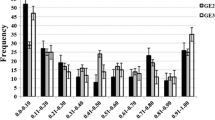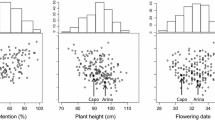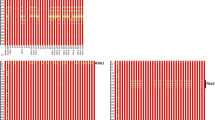Abstract
Fusarium head blight (FHB) of wheat, caused by Fusarium graminearum, is an important fungal disease in many wheat-growing areas of the world. The objectives of this study were to determine the relationship between width and duration of flower opening and incidence of FHB in wheat, and to identify DNA markers associated with narrow flower opening and low FHB incidence. It was hypothesized that wheat lines whose flowers open briefly and narrowly have a reduced risk of infection. To test the hypothesis, we crossed wheat cultivars Patterson and Goldfield to generate a population of 100 random F2-derived recombinant inbred lines (RILs). Florets of Patterson open wide; florets of Goldfield tend to stay closed. The population of RILs was characterized for FHB incidence and flower opening width (FOW) and duration in the F7:9 and F7:10 generations. Of the 305 simple sequence repeat primer pairs screened on the parents, 79 amplified polymorphic DNA bands. Pooled DNA from each of the two bulks was tested with these 79 SSR primer pairs. Four markers were found to have significant marker-trait association with low FHB incidence and narrow flower opening. The major QTL effect associated with narrow flower opening and low FHB incidence was found between the map interval Xbarc200–Xgwm210, explaining 29% of the phenotypic variation for FHB incidence averaged over six replicated tests in Indiana in 2002 and 2003. This adds credence to the hypothesis that narrow flower opening is responsible for low FHB incidence in this population. Breeding wheat lines for both morphological avoidance, such as narrow flower opening, and physiological resistance to FHB may be valuable in future breeding research to reduce crop production and grain quality losses in wheat due to FHB.




Similar content being viewed by others
References
Bai G, Shaner G (1994) Scab of wheat: prospects for control. Plant Dis 78:760–765
Chhabra AK, Sethi SK (1991) Inheritance of cleistogamous flowering in durum wheat (Triticum durum). Euphytica 55:147–150
Doerge RW, Churchill GA (1996) Permutation tests for multiple loci affecting a quantitative character. Genetics 142:285–294
Kolb FL, Bai GH, Muehlbauer GJ, Anderson JA, Smith KP, Fedak G (2001) Host plant resistance genes for Fusarium head blight: mapping and manipulation with molecular markers. Crop Sci 41:611–619
McMullen M, Jones R, Gallenberg D (1997) Scab of wheat and barley: a re-emerging disease of devastating impact. Plant Dis 81:12
Michelmore RW, Paran I, Kesseli RV (1991) Identification of markers linked to disease-resistance genes by bulked segregant analysis: a rapid method to detect markers in specific genomic regions by using segregating populations. Proc Natl Acad Sci USA 88:9828–9832
Ohm HW, Shaner GE, Ratcliffe RH, Huber DM, Buechley GC, Cambron SE (1998) Registration of ‘Patterson’ wheat. Crop Sci 38:553
Ohm HW, Shaner GE, Ratcliffe RH, Huber DM, Sharma H, Perry KL, Buechley GC, Cambron SE (2000) Registration of ‘Goldfield’ wheat. Crop Sci 40:581–582
Percival J (1921) The wheat plant. Duckworth, London
Pestsova E, Ganal MW, Röder MS (2000) Isolation and mapping of microsatellite markers specific for the D genome of bread wheat. Genome 43:689–697
Röder MS, Korzun V, Wendehake K, Plaschke J, Tixier MH, Leroy P, Ganal MW (1998) A microsatellite map of wheat. Genetics 149:2007–2023
Rudd JC, Horsley RD, McKendry AL, Elias EM (2001) Host plant resistance genes for Fusarium head blight: I. Sources, mechanisms, and utility in conventional breeding systems. Crop Sci 41:620–627
Saghai-Maroof MA, Soliman K, Jorgensen RA, Allard RW (1984) Ribosomal DNA spacer-length polymorphisms in barley: Mmendelian inheritance, chromosomal location, and population dynamics. Proc Natl Acad Sci USA 81:8014–8018
Schroder HW, Christensen JJ (1963) Factors affecting resistance of wheat to scab caused by Gibberella zeae. Phytopathology 53:831–838
Snijders CHA (1990) Genetic variation for resistance to Fusarium head blight in bread wheat. Euphytica 50:171–179
Steiner B, Lemmens M, Griesser M, Scholz U, Schondelmaier J, Buerstmayr H (2004) Molecular mapping of resistance to Fusarium head blight in the spring wheat cultivar Frontana. Theor Appl Genet 109:215–224
Ward R, Cregan P, Song Q, Shi J, Gill B, Singh S (2003) 544 BARC SSRs from Rick Ward. http://wheat.pw.usda.gov/ggpages/whatsnew/2003.shtml
Wiese MV (1987) Compendium of wheat diseases, 2nd edn. APS Press, St. Paul
Acknowledgements
The authors acknowledge the financial support from USDA-ARS, USWBSI competitive grant no. 59-0790-9-057, and Purdue University.
Author information
Authors and Affiliations
Corresponding author
Additional information
Communicated by B. Keller
Contribution from Purdue University Agricultural Research Programs as Journal Article no. 17451
Rights and permissions
About this article
Cite this article
Gilsinger, J., Kong, L., Shen, X. et al. DNA markers associated with low Fusarium head blight incidence and narrow flower opening in wheat. Theor Appl Genet 110, 1218–1225 (2005). https://doi.org/10.1007/s00122-005-1953-4
Received:
Accepted:
Published:
Issue Date:
DOI: https://doi.org/10.1007/s00122-005-1953-4




